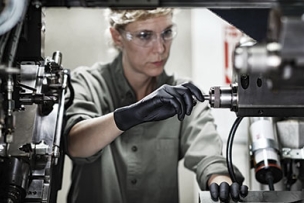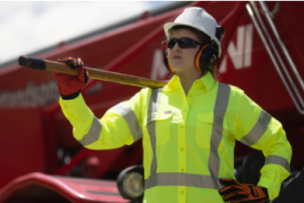Hazard: Dust
PPE: KleenGuard* A20
Dusts are solid particles ranging in size from below 1 micron to around 100 microns, which may be or become airborne, depending on their origin. If a particle is soluble, it may dissolve wherever it deposits and its components then reach the blood stream and other organs and cause disease. Cumulative exposure can lead to allergic contact dermatitis that can develop without any warning and is incurable.
KleenGuard* A20 can help protect workers against the hazard of dry particulates. This breathable, lightweight garment has the exclusive, human-centric Reflex* Coverall Design that offers an excellent fit and freedom of movement so the suit won’t rip out.
KleenGuard* A20 will also aid in meeting top KPIs:
Safety – No front seams means more protection in primary exposure areas where you need it the most.
Productivity – 7 1/2 times less likely to rip out vs. ANSI minimum sizing, which means fewer changeouts and more time on the job
Cost – Money Back Guarantee vs. Tyvek* 400 (20% savings when exclusively used for 60 days)
Sustainability – Recyclable with the RightCycle by Kimberly-Clark Professional* program to help meet sustainability goals
Quality – TAA compliant, critical for government accounts







Talk to Us!
What is the best coverall to use for covid-19 and do you have a lsit of distributors. Do they also come with hood and foot protection in one outfit.
Thank you,
Dr. Marc Boivin
31Dr. Boivin:
Thank you for reaching out and for your question.
Regarding where to buy protective clothing, you can go to www.MSCDirect.com for all your PPE and other products.
The Centers for Disease Control (CDC) and World Health
Organization (WHO) provide direction on infection prevention
and control procedures related to SARS-CoV, MERS-CoV, and
other coronaviruses. Both provide guidance to healthcare
professionals for the use of personal protective equipment
(PPE) for contact with patients with known or suspected cases
of coronavirus infections. Both suggest the use of clean,
disposable, long-sleeved gowns.
DuPont Personal Protection provides a wide range of
protective garments and accessories that address a broad
range of PPE needs.
DuPont™ Tyvek®, DuPont™ Tychem®, DuPont™ ProShield® and
DuPont™ ProClean® garments are available in disposable coverall, apron, and gown designs, as well as boot covers. Additionally, Tychem® gloves offer hand protection that along with a hooded coverall and attached socks can provide full body coverage.
Tychem® 2000 and other Tychem® fabrics with taped seams
have been tested and have passed the requirements of ASTM
Standards F16702 and ASTM F16713, the recognized blood and
viral penetration test methods in North America, respectively.
ProShield® 80 also passes the requirements of both of these
ASTM test standards.
During high-contact patient activities, especially cleaning,
disinfecting, and decontaminating, where exposure to moderate
to large volumes of bodily fluids is anticipated, a ProShield® 80
or taped seam Tychem® 2000 garment may be appropriate to
reduce the risk of bodily fluid contact.
Refer to DuPont™ SafeSPEC™ for a full list of garments that
have been tested and have passed the requirements of ASTM
Standards F16702 and ASTM F16713. Although certain DuPont
protective garments have passed the recognized ASTM blood
and viral penetration test methods in North America, they have
not been tested against specific coronaviruses. Continue to
consult the CDC for guidance on suitable PPE for protection
from coronaviruses.
A great resource you can use is DuPont SafeSpec. Based on your needs, SafeSpec will help you select the right protection for your application.
safespec.dupont.com
37Leave a reply
Your email address will not be published. Required fields are marked *